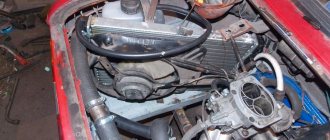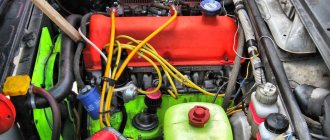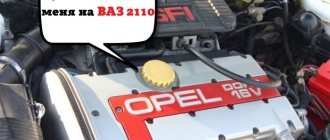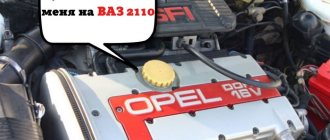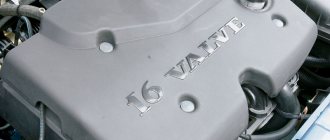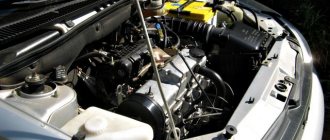Hydraulic compensators for the VAZ 2114 (GK, another name is hydraulic pushers) are self-regulating devices that automatically correct thermal valve clearances in the intake and exhaust systems.
The operation of such a device is based on the principle of incompressibility of engine oil. When the engine is running, oil constantly fills the internal cavity of the hydraulic compensator and, when a gap appears in the valve drive, moves the plunger, ensuring constant contact of the drive lever with the camshaft cam (without gap).
Hydraulic compensators
Hydraulic compensators for VAZ 2114 8 valves: installation, adjustment, replacement, additional lubrication
After installing the HA, the car engine begins to run much quieter, since the valves stop knocking. In addition, there is no need to periodically adjust the valves during vehicle maintenance.
Hydraulic compensators VAZ 2114
The only condition that should be immediately noted is the need to fill in high-quality oil, since dirty oil can cause clogging of the hydraulic compensator mechanism. A constant supply of oil (under pressure) ensures uninterrupted operation of the hydraulic system.
This supply is carried out through a special channel that has a check ball valve, which, after turning off the engine, prevents oil from draining from the channel. In addition, on the lower plane of the bearing housings there are channels through which oil is supplied to the camshaft journals.
The presence of mechanical inclusions and other impurities in the oil leads to rapid wear of the plunger pair of the hydraulic valve and, as a consequence, severe wear of the camshaft cams.
Operation of the hydraulic compensator
The installed hydraulic compensators on the VAZ 2114 (8 valves) may, over time, begin to produce a characteristic knocking sound, which will indicate the presence of certain problems.
Among the main reasons for the appearance of such a sound, experts identify:
1. Problems with the quality and purity of the oil or the use of the wrong brand, in which the viscosity, temperature indicators, etc. are not appropriate. 2. Malfunctions of the oil system, namely:
- the presence of plaque and dirt in the oil channels;
- airing the system (the presence of air increases the oil compression rate);
- oil filter clogged;
- malfunction of the oil pump.
3. Mechanical failures of the main body:
- presence of exhaustion in the plunger pair;
- problems with the correct operation of the oil supply valve (options: situational sticking or failure);
- defects on the surface of the hydraulic compensator.
It is important to note at what engine temperature a knock appears in the hydraulic tappets. If this happens when it is cold, and when it warms up sufficiently, the knocking disappears, then this situation is quite acceptable. If, on a fully warmed-up engine, the picture does not change and the sound does not disappear, then this indicates existing malfunctions that require elimination.
Hydraulic compensator kit
Hydraulic compensators for VAZ 2114 8 valves: installation, malfunctions and repairs
Hydraulic compensators for the VAZ 2114 (GK, another name is hydraulic pushers) are self-regulating devices that automatically correct thermal valve clearances in the intake and exhaust systems.
The operation of such a device is based on the principle of incompressibility of engine oil. When the engine is running, oil constantly fills the internal cavity of the hydraulic compensator and, when a gap appears in the valve drive, moves the plunger, ensuring constant contact of the drive lever with the camshaft cam (without gap).
Hydraulic compensators
Select the vehicle modification to search for hydraulic compensators
- Lada Samara 2108/2109/2115 2108,2109,2115 Hatchback 1100 53 hp id3057 Engine: volume - 1.1 l., power - 53 hp, type - petrol, model - BA3 21081. Drive: front-wheel drive. Year of manufacture: 1988-1994
- Lada Samara 2108/2109/2115 2108,2109,2115 Hatchback 1100 58 hp id7445 Engine: volume - 1.1 liters, power - 58 hp, type - petrol, model - BA3 21081. Drive: front-wheel drive. Year of manufacture: 1996-1994
- Lada Samara 2108/2109/2115 2108,2109,2115 Hatchback 1300 61 hp id3060 Engine: volume - 1.3 l., power - 61 hp, type - petrol, model - BA3 2108. Drive: front-wheel drive. Year of manufacture: 1991-1994
- Lada Samara 2108/2109/2115 2108,2109,2115 Hatchback 1300 63 hp id3053 Engine: volume - 1.3 l., power - 63 hp, type - petrol, model - BA3 2108. Drive: front-wheel drive. Year of manufacture: 1988-1994
- Lada Samara 2108/2109/2115 2108,2109,2115 Hatchback 1300 65 hp id3054 Engine: volume - 1.3 l., power - 65 hp, type - petrol, model - BA3 2108. Drive: front-wheel drive. Year of manufacture: 1986-1994
- Lada Samara 2108/2109/2115 2108,2109,2115 Hatchback 1300 68 hp id5699 Engine: volume - 1.3 liters, power - 68 hp, type - petrol, model - BA3 21115. Drive: front-wheel drive. Year of manufacture: 1996-1994
- Lada Samara 2108/2109/2115 2108,2109,2115 Hatchback 1500 68 hp id3061 Engine: volume - 1.5 liters, power - 68 hp, type - petrol, model - BA3 21083. Drive: front-wheel drive. Year of manufacture: 1991-1994
- Lada Samara 2108/2109/2115 2108,2109,2115 Hatchback 1500 71 hp id4831 Engine: volume - 1.5 liters, power - 71 hp, type - petrol, model - BA3 2111. Drive: front-wheel drive. Year of manufacture: 1995-1994
- Lada Samara 2108/2109/2115 2108,2109,2115 Hatchback 1500 72 hp id3056 Engine: volume - 1.5 liters, power - 72 hp, type - petrol, model - BA3 21083. Drive: front-wheel drive. Year of manufacture: 1988-1994
- Lada Samara 2108/2109/2115 2108,2109,2115 Hatchback 1500 75 hp id105664 Engine: volume - 1.5 liters, power - 75 hp, type - petrol, model - BA3 21083. Drive: front-wheel drive. Year of manufacture: 1986-1994
- Lada Samara 2108/2109/2115 2108,2109,2115 Hatchback 1.5 78 hp id20166 Engine: volume - 1.5 liters, power - 78 hp, type - petrol, model - VAZ-2111. Drive: front. Year of manufacture: 1996-1994
- Lada Samara 2108/2109/2115 2108,2109,2115 Hatchback 1500 72 hp id53073 Engine: volume - 1.5 liters, power - 72 hp, type - petrol, model - BA3 21083. Drive: front-wheel drive. Year of manufacture: 1987-1993
Eliminating knocking
Sometimes car owners make attempts to independently solve the problem of knocking hydraulic compensators. I have nothing against it, since it’s quite possible to wash or repair the element with your own hands.
Be prepared that the work will take a lot of time and effort. It's not worth going there without experience in car repair. You should not rely entirely on flushing, since it does not always restore normal operation of the compensator. This is due to the fact that the knocking may be caused by oil or malfunctions in other engine systems.
Let’s not forget about situations where you can hear a knock when it’s cold, but it disappears when it’s hot. The reason here is definitely not the low oil temperature. This phenomenon is common. Therefore, car owners often ignore these symptoms, since the knocking soon disappears.
When tapping one hydraulic compensator, you can try this repair method:
- turn the crankshaft so that the valve suitable for the problematic main valve opens;
- turn the valve with the spring at an angle so that you can move the elements that are not positioned correctly;
- start the engine.
If after this the knocking does not disappear, you cannot do without a full-fledged professional diagnosis. A similar repair technique is relevant for VAZs and Prioras, for example.
When the engine is not warmed up and knocks, there is nothing terrible. Most likely, the lubricant is still thick and has not had time to warm up. That is, knocking when cold is acceptable and you can safely drive on with it. If the sound does not disappear after warming up, then leave the car alone until the problem is resolved.
Replacement procedure
If you decide to install new expansion joints, you should not be afraid to take on the work. The procedure is not the most complicated and is typical for almost all engines. That is, the instructions presented will help you regardless of what kind of car you have.
But it’s still worth having an official repair and maintenance manual on hand. And then you will say that it’s all my fault.
Please note that when replacing parts on some machines it is necessary to additionally replace the cover gaskets. Otherwise the replacement principle is identical
Act according to the plan and do not deviate from the sequence of stages:
- remove the valve cover;
- remove the sprocket from the camshaft (use a wire, carefully picking up the desired part and pulling it up);
- check the tensioners and dampers for wear (if these elements are already well worn, it is better to replace them immediately);
- remove the bed, having first removed the fastenings from the crankshaft;
- remove the rockets and place them in the same order as they were located in the engine (label, for example);
- dismantle all the compensators one by one and place them in front of you in the order of installation in the car;
- clean and rinse the oil pipeline and installation sites of new hydraulic compensators;
- screw in new or cleaned compensators according to the purchased tickets;
- when tightening, be careful with force, do not overdo it (use a torque wrench);
- it is better to clean or replace the valves;
- Reassemble the parts in reverse order.
That's all. At this point, the work of replacing hydraulic compensators can be considered completed.
To avoid such procedures in the future, be careful when choosing oil. It is because of this that hydraulic compensators most often knock. If the problem is not there and even after changing the oil the sound does not go away, then I advise you to additionally consult with specialists and carry out diagnostics at a service station.
Messages 12
1 Topic from Lada-2108 2011-03-12 09:51:14
- Lada-2108
- User
- Offline
- Registered: 2010-08-21
- Messages: 633
- Reputation: [ 0 | 0 ]
Topic: Hydraulic valve lifters!
The obvious advantage of hydraulic compensators is the absence of a gap between the pusher and the camshaft, and accordingly the “shock” loads are reduced! And there is no need to climb with a feeler gauge and measure the thermal gap =)
The current hydraulic compensator affects the “charged motor”. Do hydraulic compensators influence the valve timing? Is it possible to install a compensator on the head 083.
2 Reply from Gloomc 2011-03-12 09:55:56
- Gloomc
- User
- Offline
- Registered: 2010-08-07
- Messages: 32
- Reputation: [ 0 | 0 ]
Re: Hydraulic valve lifters!
Well, in 12 cars, after all, hydraulics are immediately available in stock))
but putting them in the 8th head is a controversial issue
3 Reply from Lada-2108 2011-03-12 10:00:55
- Lada-2108
- User
- Offline
- Registered: 2010-08-21
- Messages: 633
- Reputation: [ 0 | 0 ]
Re: Hydraulic valve lifters!
Well, in 12 cars, after all, hydraulics are immediately available in stock))
familiar, I just basically want to understand that they are needed to “charge” the engine, and how they affect the operation of the engine, or their role is purely to avoid poking with a dipstick.
4 Reply from Konstantin 10 ru 2011-03-12 11:26:45
- Konstantin 10 ru
- User
- Offline
- Registered: 2009-09-01
- Messages: 353
- Reputation: [ 1 | 0 ]
Re: Hydraulic valve lifters!
They are on the classic with the 8th head.
5 Reply from Lada-2108 2011-03-16 17:09:36
- Lada-2108
- User
- Offline
- Registered: 2010-08-21
- Messages: 633
- Reputation: [ 0 | 0 ]
Re: Hydraulic valve lifters!
They are on the classic with the 8th head.
What a classic, and even with 8 heads, and even with hydraulic pushers. injector chtoli 21074.
6 Reply from MasterGray 2011-03-17 08:44:22
- MasterGray
- User
- Offline
- Registered: 2008-11-10
- Messages: 411
- Reputation: [ 0 | 0 ]
Re: Hydraulic valve lifters!
Probably 21214 motor. but there is no 8 head there.
7 Reply from Konstantin 10 ru 2011-03-17 10:42:16
- Konstantin 10 ru
- User
- Offline
- Registered: 2009-09-01
- Messages: 353
- Reputation: [ 1 | 0 ]
Re: Hydraulic valve lifters!
on the shnivy there is a head of 8 valves with compensators, I expressed it incorrectly in the previous post.
8 Reply from MasterGray 2011-03-18 09:32:30
- MasterGray
- User
- Offline
- Registered: 2008-11-10
- Messages: 411
- Reputation: [ 0 | 0 ]
Your advantages when purchasing at Autocompas.ru
- Huge selection of auto parts and low prices;
- Fast delivery, usually within 24 hours;
- Warranty and right of return;
- Emphasis on proven and branded manufacturers of all price segments;
- Safe and convenient online purchase with many payment options;
- Qualified support and advice + recommendations from experts when choosing and purchasing.
Range of auto parts in stock and on order
A wide variety of manufacturers and high-quality auto parts guarantee the mobility of your car and safety on the roads. A huge assortment is constantly available from stock online. Certified and reliable aftermarket suppliers, dealers, and regional market participants provide a full range of auto parts at reasonable prices. Our knowledgeable support staff is always available to assist you in your search.
Quality of service in our online store
The service and online offers from Autocompas.ru have already won several awards and made us a leader in the Russian market in the field of sales of auto parts for foreign cars, 40+ thousand people visit the site every day and many of them become our regular customers. Satisfied customers are our goal. Rely on Autocompas.ru as a reliable supplier of auto parts.
29.11.2019
A review section has been introduced on the site, using the latest technologies, now each client can write a review from their personal account.
01.01.2019
A completely new and intuitive returns system.
23.05.2018
Global update of the “Delivery” section! Track numbers in your personal account and convenient cargo tracking.
➤ Replacement of hydraulic compensators on Lada Granta 16 valves
The average service life of hydraulic compensators on the Lada Grant Sedan/Liftback is 50-60 thousand km. After which they need to be replaced with new ones. Mandatory maintenance after 15,000 km. Violation of maintenance intervals by the owner leads to premature wear of the elements.
The process of independently replacing hydraulic compensators is completely within the power of every car owner. To help, we provide the repair instructions below.
Preparatory stage
Necessary tools, materials:
- set of hydraulic compensators (16 pieces);
- oil seals, plugs, sealing gaskets;
- anaerobic sealant or Loctite - industrial glue;
- new rubber rings for injectors;
- engine oil;
- filter element;
- set of automotive tools;
- additional lighting.
- We place the car on the inspection channel and squeeze the parking brake lever to prevent an arbitrary rollback. Open the hood.
- Disconnect the terminal from the battery, remove the decorative plate, air ducts, and pipes.
- We remove the high-voltage wires; they prevent the dismantling of the intake manifold. Unscrew the throttle cable and remove the ignition coil.
Remove the ignition coil
- Unscrew the upper intake manifold mounting bolts.
- Loosen the generator mounting nut and remove the generator belt from the splines.
Loosen the generator nut
- We unscrew the screws around the perimeter and move the fuel rail to the side.
Removing the fuel frame
- We unscrew the bolts at the bottom of the intake manifold mounting and remove it.
- Carefully remove the camshaft pastel and the camshafts themselves.
We remove the camshafts
- Experts recommend replacing all hydraulic compensators at the same time. It is not advisable to leave worn ones in their original places, since repeated repairs will soon be required.
All compensators need to be replaced
- We change engine oil as needed. The decision is made by the owner, based on the mileage traveled by the car.
- There is no need to lubricate the hydraulic compensators (hereinafter referred to as the pushers); they are supplied in the original packaging with factory lubricant. Use a rag to clean the seat of the camshaft pastel.
No need to lubricate, compensators have factory lubricant
Note to the driver! It is strictly forbidden to use sharp or cutting objects when cleaning the block, so as not to damage the mirror surface.
- We install new pushers, camshaft pastel.
- We apply anaerobic sealant or Loctite around the perimeter of the block, depending on what is available.
Apply sealant
- We align the crankshaft and camshaft shafts according to the marks, and put on the drive belt. We fix the generator mount.
- We put on the plastic cover, air ducts, and complete the assembly.
Self-replacement of hydraulic compensators on the Lada Grant (16 valves) is completed. Subsequent maintenance after 15,000 km.
Note to the driver!
When first started, the pushers will knock for a while. The knocking noise will disappear after they are completely filled with engine oil.
Review of manufacturer prices and the cost of hydraulic compensators for the Lada Granta
| See all advertisements in the archive |
| Name / catalog article | Price, rub.) |
| Original 2191-1007300 | From 2600 / set 10 pieces |
| RUVILLE 267200 | From 230/unit |
| RUVILLE 267687 | —/— |
| INA 420 0073 10 | —/— |
| INA 420 0127 10 | —/— |
| JSC "Prosport" 845412 | From 250/unit |
| JSC "Prosport" 845931 | —/— |
*prices are current as of October 22, 2018.
Technical data of pushers:
- Weight: 1.150 kg;
- Size: 210 x 175 x 90 mm.
Reviews
| № | Positive |
| 1. | Victor: the valve mechanism works properly, there are no complaints. At 55,000 km the valve began to knock, so I contacted the workshop. It turned out that the fastening nut had become loose. |
| 2. | Vasily: I don’t know of any problems with the engine and its mechanisms, I regularly carry out technical inspections and fill in high-quality oil. |
| 3. | Sergey: at 65,000 km I replaced two pushers, the service life is good. The remaining hydraulic compensators are normal, the master said they were in good working order. |
| 4. | Vladlen: I’ve heard a number of negative reviews about the quality of the pushers, I can’t confirm, the machine works like a watch. I believe that careful handling of equipment and high-octane fuel are the key to long-term operation. |
| 5. | Vladimir: at 70,000 km I replaced a set of pushers. I think that the resource is more than sufficient. I carried out the work myself, the replacement procedure is not complicated. |
| Negative | |
| 1. | Slavik: my pushers went off at 35,000 km. The reason is the quality of workmanship and the fineness of adjustment. It is obvious that the technology is broken. Under warranty, they replaced a set of new ones. |
| 2. | Gennady: after 40,000 km, I replaced the set of pushers. Initially they knocked on “cold”, then constantly. The workshop said that there was a manufacturing defect. |
| 3. | Ivan: replaced two pushers in a year. What kind of workmanship can we talk about? I leave my negative review. |
Reviews
| See all advertisements in the archive |
| № | Positive |
| 1. | Vasily: I drove a little more than 50,000 km, there is no knock in the gas distribution mechanism. I regularly fill up with high-octane fuel and fill in Shell 10W-40 semi-synthetic oil. |
| 2. | Konstantin: in two years of active operation of the machine, the valve knocked once. As the service station worker found out, the reason was that the fastening nut was not tightened sufficiently. Half an hour later I was driving the car again. |
| 3. | Vladlen: I recently noticed dark-colored exhaust gases coming from a car, I thought there was a problem with the gas distribution mechanism. During the diagnostics, it turned out that there was a violation in the enrichment of the mixture in the system, as a result of which carbon deposits formed. |
| 4. | Ignat: I heard a lot of complaints about the gas distribution mechanism, I didn’t have any breakdowns in a year and a half of using the car. Perhaps the reason is constant maintenance, careful handling, refueling with high-quality oils and fuel. |
| 5. | Ivan: in two years of using the car, I cleaned the gas distribution mechanism once for preventive purposes. The machine works stably, there are no complaints. |
| Negative | |
| 1. | Vitaly: after 55,000 km, the valves began to knock, I took the car to the service center, and it turned out that the leg was deformed. Replaced with new ones, they gave a guarantee. Dissatisfied with the quality of workmanship. |
| 2. | Kirill: at the first convenient opportunity, re-tighten the valve mechanism on the Lada Granta. Lots of defects, poor quality fitting, loose knots. |
| 3. | Slavik: in the third year of operation of the machine, I replaced the valve mechanism with a new one. The old one has fallen into disrepair. |
Conclusion
The average service life of the gas distribution mechanism of the Lada Granta does not exceed 50 - 60 thousand km. In order not to reduce the resource, periodically carry out preventative maintenance on your car, replace worn parts with new ones.
Refilling with high-quality motor oils and high-octane fuel will only increase the life of the valve mechanism.
Often, the cause of premature wear of timing elements is an aggressive driving style. Increased load and high temperatures contribute to premature wear of components.
Source
What are they made of?
There are several types of them:
- Hydraulic pusher;
- Hydro support;
- Roller hydraulic pusher;
- Hydraulic support for installation in a lever or rocker arm.
What types of hydraulic compensators are there for the engine and their design?
The design is similar for all. There are main elements due to which the hydraulic compensator works:
- Housing with oil supply hole;
- Pin with a spring and a ball-shaped valve.
Suspension
Shock absorbers, Shock absorber strut, Shock absorber bump stop, Shock absorber boot, Shock absorber bushing, Rear shock absorbers, Shock absorber support, Support bearing, Front shock absorbers, Shock absorber silent block, Springs, Rear springs, Spring support, Front springs, Suspension arms, Control arm silent block, Rear control arm, Bolt Arm, Upper Arm, Left Arm, Lower Arm, Front Arm, Cross Arm, Right Arm, Trailing Arm, Ball Joint, Hub, Hub Bearing, Hub Nut, Hub Bolt, Rear Hub, Hub Cap, Front Hub, Hub Seal, Stud hubs, Stabilizer, Stabilizer bushings, Stabilizer links, Springs, Spring bolt, Spring bushing, Rear spring, Spring bracket, Spring leaf, Spring pin, Front spring, Spring cushion, Spring silent block, Spring shank, Spring stepladder, Air suspension, Air suspension compressor, Air springs, Air suspension unit, Steering knuckle, Swivel bearing, Trunnion, Kingpin, Rear beam, Beam silent block, Subframe, Subframe silent block, Wheel spacers
Hydraulic compensators for VAZ 2114: how to get rid of knocking
Experts recommend two ways to solve the problem:
- Changing the oil and oil filter is carried out when the oil has already used up some of its service life and has a bad odor and color (dark brown).
- Removing hydraulic tappets - used if adding oil does not solve the problem. The removed HAs need to be inspected and, if the wear is insignificant, then disassembled and washed separately.
During the process of removing hydraulic compensators, you should remember/write down where and which hydraulic compensator was installed previously. This way, during the reverse operation (reinstallation) there will be no problems.
Hydraulic compensator device
To flush hydraulic compensators, the following steps should be performed sequentially:
- Open. When performing an autopsy, you should knock the core out of the housing. To do this, forcefully strike the glass with the open part of the glass (through the fabric) on a hard surface. After opening, two separate elements are obtained - the core and the body itself. The core consists of: a piston, a cylinder and a spring. The piston is easily removed from the cylinder.
You should not knock on hard but thin materials (for example, plywood), as this complicates the task by “absorbing” shock impulses.
- There is a hydraulic valve inside the piston, which must be cleaned. They open it by picking out its cover with a (thin) screwdriver.
- All these parts must be thoroughly washed (especially the valve hole and the well at the bottom of the housing).
- Now you need to assemble the piston: the ball is placed on the spring, everything is covered with a lid, which is pushed into the mount with a thin screwdriver. A piston spring is installed on top and covered with a cylinder.
- Now the glass is turned over and filled with oil.
- Using a thin rod, we press on the valve ball, pushing the piston into the glass. This operation should be repeated several times, until air stops escaping from under the valve.
You need to make sure that the piston is not pressed. To do this, press on the cylinder with your finger.
- Pour a little oil into the hydraulic pusher body, and then insert the core assembled earlier into it (push with your hands with sufficient force).
Installation of hydraulic compensators
After washing and installing the hydraulic valve in place, check the results: if washing does not help eliminate the knocking, then the only solution to the problem is to replace the hydraulic compensators.
Please note that after replacement, some noise may occur when the motor is first started. This will last until the hydraulic compensators are completely pumped.
If none of the above helps...
This means that the hydraulic compensators are broken. They need to be changed. Preferably all at once, even if not all are broken. There are two reasons for this:
- No one guarantees you that others will not break after some time. That is, the risk that you will do or pay for the same work several times is very high. It’s better to change everything at once - it will take less time, and the money will be safer.
- Typically, hydraulic compensators are sold as a set and not individually. Either way, you'll take it all. So why not install all new ones at once?
And we will end the article with where we probably should have started.
( 1 rating, average 5 out of 5 )
Bottom line
In rare cases, hydraulic compensators begin to knock or break completely. Basically, they serve reliably and unpretentiously throughout the entire declared resource of the power unit. They do not require maintenance, their operation is fully automatic. For preventive purposes, it is recommended to remove hydraulic mechanisms after 80-100 thousand kilometers and clean them of carbon deposits that form after using low-quality motor oil. Replacing one compensator will cost 150-500 rubles, it all depends on the design of the engine. If you turn to a specialist, you will have to pay several thousand rubles on top for the work. To increase the service life of the compensator, remove low-quality lubricants from the engine’s diet, giving preference to famous oil manufacturers: Motul, Castrol, Liqui Moly.

